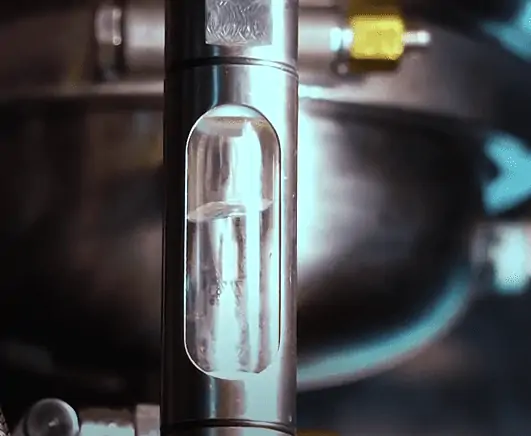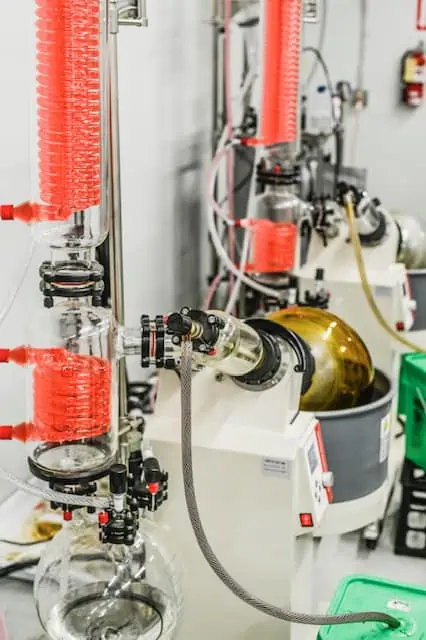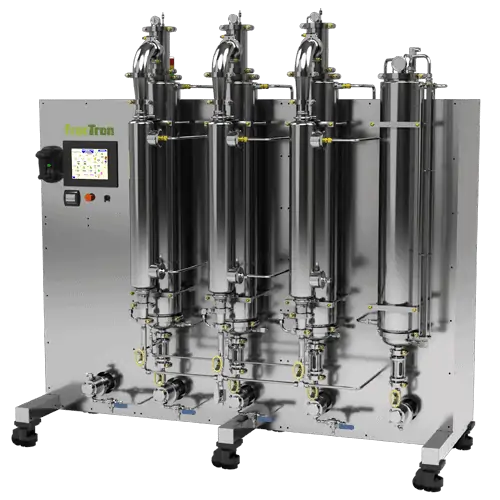Whether extracting using ethanol as a solvent, or winterizing crude oil with ethanol, fractional distillation is a vital tool for solvent recovery from a hemp extract. While there are many methods and equipment used for this process, like the rotovap, extraktLAB has a falling film evaporator solution that expedites the solvent recovery process makes certain of near-total solvent removal levels to ensure quality extract products. Read on to find out the process of fractional distillation for solvent recovery, various methods, and equipment used to complete this process.
Fractional Distillation for Solvent Recovery from a Hemp Extract
Solvent recovery is necessary to recover or remove solvent from CBD oil after ethanol extraction or winterization. The first step in removing ethanol from an extract is to heat the ethanol to its boiling point where it is evaporated. The ethanol vapor is then transported to a different location where it is condensed back into a liquid. This process is called fractional distillation. To accomplish fractional distillation quickly and with high throughput, solvent recovery systems must be designed that can keep up with the solvent removal demand.
The following portion of the guide will first review the key elements of evaporator design and then review the common equipment used for solvent recovery. Therefore, applications in hemp processing include:
- Removal of water from ethanol-water mixtures
- Removal of ethanol from winterized CBD oil
- Removal of pentane from isolate crystal supernatants
- Separation of denaturants from ethanol. Ex. heptane and ethanol
Fractional Distillation System Design
Evaporation is the process of changing a liquid into a gas. Evaporator equipment is typically designed to produce a thin film on a heated surface so that solvents will volatilize quickly and efficiently.
Condensation is the process of changing a vapor or gas into a liquid. The liquid in this case is called a condensate. The term thin film is also applied to a condenser because as condensable vapor gas encounters a cold condenser, a thin condensate film forms automatically. Careful engineering of the condensation path is a key aspect to the overall fractional distillation process. The thin condensate film is typically removed by gravity.
Condensers are typically situated in two positions relative to the evaporator. The first position is in close proximity to the evaporator. This is called a short path. In the second position, the condenser equipment is located remote from the evaporator.
Fractional Distillation is the process of evaporation of a volatile from a fluid and condensation of that volatile to produce a separation between the components that are not evaporated and the components that are condensed.
Fractional Distillation systems and distillation Equipment will typically incorporate both an evaporator and a condenser so as to provide a separation between the evaporated fluid and condensate.
Thin Film Evaporator Design for Heat Sensitive Products
Design of evaporators for processing botanical extracts often requires careful consideration of the stability of the extracts that are being distilled. An evaporator is a piece of equipment that is designed to remove selected volatile components from a fluid. Selectively removing solvents from fluids is accomplished by controlling temperature and pressure of the fluid.
Thin film evaporators are popular within botanical industrial processing because they are specifically designed to evaporate volatile solvents from heat sensitive products. Oftentimes botanical extracts can be thermally labile and therefore are susceptible to degradation.
The word thin-film refers to the process of coating the solution to be evaporated into a thin film on a heated surface. The thinner the film, the better the heat transfer and the better the mass transfer and therefore the shorter the time for evaporation. Short times for evaporation help preserve the Integrity and consistency of heat sensitive products.
There are several different types of thin film evaporator that are used in industrial evaporation. The most popular type of heat exchangers for evaporation include shell & tube evaporators and wiped film evaporators. Lab scale evaporators would include a rotovap.
In order to get a thin film, the evaporator system must be designed carefully. For example, some viscous or slurries require rotors and blades to spread a thin film on a heated surface. Less viscous products may only not need complicated apparatus to obtain a thin film.
Evaporator Design Types That Will Create a Thin Film
The “Rotovap”
A Rotary Evaporator, commonly referred to as a rotovap, may be the most common way to accomplish solvent removal in the hemp industry. This form of equipment uses a large, rotating, round bottom flask, vacuum pump, heating bath, chilled condensation surface and collecting flask.
A vacuum pump is necessary to reduce the boiling point of solvents like ethanol as to prevent cannabinoid damage with higher temperatures. The ethanol boiling point is roughly 78.2ºC compared to a relative boiling point of 160-180℃ for CBD making it easier to volatilize the solvent fully and leave an oil consisting primarily of cannabinoids and terpenes.
A mixture of winterized oil and ethanol is typically introduced to the round bottom flask which is then warmed by the heating bath to vaporize volatile components from CBD oil. A thin film forms on the sides of the spinning glass that enables quick evaporation of the solvent. Once evaporated, the vaporized components are collected on a chilled condenser and conveyed away to a receiving flask.
To further ease the removal of residual solvents, a rotovap creates a thin film of oil on the inside of the rotating flask. As it rests in the heating bath, the rotation makes the oil thin enough to increase the rate of evaporation. Once it has fully evaporated, a rotovap will most often use a chilled condenser to collect the evaporated solvents where it will collect into a receiving flask.
While a rotovap is an effective ethanol remover and common in the ethanol extraction process, they are not without their drawbacks. An obvious disadvantage is the large glassware necessary for a rotovap to operate.
A rotovap is an effective means of fractional distillation, but it is not very scalable and is unlikely they could be used for any sizable hemp extraction process.
With a throughput of roughly 5-10L/hour, it is not uncommon to have five to ten rotovaps in a single solvent removal system, depending on the manufacturer. This means more breakable glass, more possibility for equipment to go wrong, and more hands needed to monitor the equipment.
Falling Film Evaporator
A falling film evaporator is comprised of a bundle of parallel tubes that are welded together at each end. The tube bundle is encased in a jacket that allows heat transfer fluid to be pumped across the outside of the tubes. This type of evaporator is also known as a shell and tube evaporator. The following figure shows the components of a traditional falling film evaporator:
The tube bundle is typically vertical but horizontal configurations are also common. In a vertical configuration, the solution to be evaporated is distributed to the inside of the tubes while the outside of the tube is heated with a circulating heat transfer fluid. The distribution of the fluid to the inside of the tubes is engineered so that only the inside of the tube is with the solution to be evaporated.
As the solution is heated, evaporation of the volatile components occurs and the vapor is then conveyed away to a condenser. Removal of the vapor to the condenser can be accomplished with a convective gas or by diffusion alone.
Falling film evaporators are designed to distill free flowing extracts that will readily coat the inside of a tube under gravity without globbing up, bridging, or otherwise blocking the tube. This tube blocking is referred to as fouling.
Typically the larger the evaporator surface area, the greater the solvent removal or solvent recycling system capacity. Obviously as the number of tubes in the evaporator increases, the greater the surface area of the heat exchanger and the greater the solvent recycling capacity. Likewise, as the tube diameter decreases, the surface area also increases. So, it would follow that the best evaporators should have a small inside tube diameter and also Incorporate many tubes.
However there is a natural lower limit to the tube diameter. As the tube diameter decreases, the likelihood of fouling or bridging will also increase. So the inside diameter of the tubes must be small enough to provide sufficient surface area for the evaporation capacity and also large enough to prevent fouling.
Designed for free flowing fluids of low viscosity, a falling film evaporator is a key thin film evaporator for chemical processing. Pilot scale multi stage systems such as the fracTron enable the processing of a wider range of viscosities than other evaporators in the hemp market.
Falling film refers to a film that spreads over an evaporative surface by gravity. The fluid in this case must have low viscosity at the evaporator temperature so that it can flow and evaporate. This generally applies to fluids with viscosities with 2 cP or less. Most falling film evaporators utilize a siphon to decrease the pressure within the falling film evaporator, decreasing the boiling point of the liquids, and directing the flow of the vapor to a condenser.
The issue with traditional falling film technology is its lack of ability to address drastic changes of the physical properties of the mixture as fractional distillation occurs. Removing the last remaining precentages of a solvent becomes increasingly hard to remove. Single stage falling film evaporators have yet to address this issue, leaving extraktLAB to address the problem with their own solution: the fracTron 1000.
fracTron, a 3-Stage Falling Fractional Distillation System
A key issue with the standard single stage falling film evaporator is that As the liquid mixture flows through the tubes of the falling film evaporator, it changes composition due to evaporation of the volatile solvent. The change in composition changes the physical properties of the macroscopic mixture – including the boiling point. While single stage systems struggle to accomplish full solvent removal, extraktLAB’s fracTron 1000 utilizes a triple pass falling film system to change the operating temperature of the evaporator as the composition of the liquid mixture changes.
By doing this, the three-stage distillation in the fracTron 1000 far more effectively removes the last remaining percentages of ethanol or other solvents. As the ethanol/oil mixture moves through each of the three passes, temperatures and vacuum pressures can be adjusted to compensate for increased boiling points and viscosities where other evaporation methods would have difficulty. This creates an optimal removal of solvents before the final process of distillation.
However, complete solvent removal is difficult to achieve with a single stage falling film evaporator because of the single temperature setpoint. As the liquid mixture flows through the tubes of the falling film evaporator, it changes composition due to vaporization of the volatile component. The change in composition changes the physical properties of the macroscopic mixture – including the boiling point.
Final Thoughts on Fractional Distillation
As stated previously, solvent recovery is key to a quality hemp extract after the extraction or winterization process. Without fractional distillation by some means or another, total solvent recovery simply isn’t feasible. While standard rotovap equipment has been the norm for the solvent removal process, falling film evaporation has proven to be a cut above in the process. Better still, extraktLAB’s fracTron 1000 takes falling film to a new level with three stage solvent removal and the highest possible throughput in the extraction industry.






